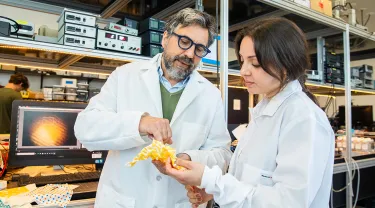Silk has been cultivated and harvested for thousands of years. It is best known for the strong, shimmering fabric that can be woven from its fibers, but it also has a long history of use in medicine to dress injuries and suture wounds. At Tufts’ Silklab, Fiorenzo Omenetto and his colleagues are building on silk’s legacy, proving that this ancient fiber could help create the next generation of biomedical materials.
Silk moth caterpillars, known as silkworms, extrude a single sticky strand from their mouths to form cocoons, which are harvested by silk farmers to make thread. At its core, silk is a mixture of two proteins: fibroin, which provides the fiber’s structure, and sericin, which binds it together. With a few steps in the lab, Tufts researchers can remove the sericin and dissolve the fibers, turning a dry cocoon into a fibroin-filled liquid.
“Nature builds structural proteins that are very tough and very strong,” said Omenetto, Frank C. Doble Professor of Engineering and director of the Silklab. “Your bricks are these fibroin proteins floating in water. From there, you can build whatever you want.”
One of Omenetto’s lines of research has been finding ways to use silk to help repair and regrow bone, blood vessels, nerves, and other tissue. Silk is biocompatible, meaning it doesn’t cause harm in the body and it breaks down in predictable ways. With the right preparation, silk materials can provide necessary strength and structure while the body is healing.
Moreover, silk is remarkably good at stabilizing bioactive molecules that can be added to it, such as antibiotics or enzymes, and keeping them from degrading. For example, researchers found that blood samples mixed and dried with silk fibroin remained stable at high temperatures for multiple months. They have had similar findings with vaccines—and silk may also help create better tests for drug-resistant bacteria.
A prime interest of Omenetto’s is harnessing the unique properties of dissolved silk proteins to create highly accurate chemical sensors. Silk could hold and preserve the molecules needed to make diagnostic tests or detect potentially harmful bacteria.
“Having a material that can hold all of these exciting functions, we have to try to decide what’s going to be the most impactful,” Omenetto said. “If you had all the Lego bricks in the world, what would you build?”
